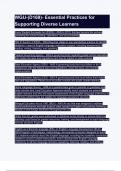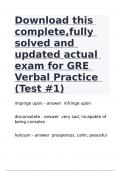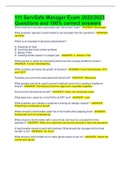WGU-(D169)- Essential Practices for
Supporting Diverse Learners
Every Student Succeeds Act (ESSA) - ANS-In 2015, this law became the primary
governing for school funding, operations, and accountability.
Title III Section of ESSA - ANS-Requires states to use standardize practice to identify
students in need of English language instruction support, including assessment in
reading, writing, listening, and speaking.
Federal Governing Agency - ANS-A governing body regarding public school education
that makes the laws and regulations and has an impact on state policies.
State Education Agency (SEA) - ANS-A governing body that must follow or be in
compliance with the federal laws and regulations, enact the laws, and monitor
implementation.
Local Education Agency (LEA) - ANS-A governing body that must follow their states
laws and regulations. Places such as public schools and public charter districts.
Home Language Survey - ANS-Is a questionnaire given to parents or guardians that
helps schools and Local Education Agencies identify which students are potential
English learners and who will require assessment of the English language proficiency to
determine whether they are eligible for language assistance services.
Bilingual Education Act of 1967 (BEA) - ANS-An act that was designed to address
dismal performance and high dropout rates caused by English only policies following a
decade of anti-foreign sentiment throughout the US.
Under this Act, grants were authorized to distribute funds directly to school district so
that they could invest in greater resources, training, and development to teach language
minority students English.
English as a Second Language (ESL) or English Language Development (ELD) -
ANS-Program of techniques, methodology, and special curriculum designed to teach
ELs students explicitly about the English language, including the academic vocabulary
needed to access content instructions, and to develop their English language
proficiency in all four language domains (speaking, listening, reading, and writing).
,Language(s) used for instruction: English with little use of the Els primary language(s).
Structured English Immersion (SEI) - ANS-Program designed to impart English
language skills so that the Els can transition and succeed in an English-only classroom
once proficient.
Language(s) used for instruction: English with little use of the Els primary language(s).
Transitional Bilingual Education (TBE) or Early-Exit Bilingual Education - ANS-Program
that maintains and develops skills in the primary language while introducing,
maintaining, and developing skills in English. The primary purpose of a TBE program is
to facilitate the ELs transition to an all-English instructional program, while students
receive academic subject instruction in the primary language to the extent necessary.
Language(s) used for instruction: Students primary language and English.
Dual Language or Two-Way Immersion - ANS-Bilingual program where the goal is for
the students to develop language proficiency in two languages by receiving instruction
on English and another another language in a classroom that is usually comprised of
half primary-English speakers and half primary speakers of the other language.
Language(s) used for instruction: English and another language.
Individualized Education Plan or Program (IEP) - ANS-A written document, developed
at a meeting of the (What is the term?) team, that describes specialized instruction and
related services to address the student's needs that result from the student's disability.
Indicates exactly how the child will receive individualized services and supports
provided at school.
World-Class Instructional Design and Assessment (WIDA) - ANS-Is a partnership of 40
states that developed standards and assessments for English learners.
WIDA Standards Framework - ANS-Describes conceptualization of language learning in
addition to the nature of academic language and its relation to language development.
WIDA Can Do Philosophy - ANS-Is based on the belief that all students bring to their
learning cultural, experiential, and linguistic practices, skills, and ways of knowing from
their homes and communities.
,Guiding Principles of Language Development - ANS-Represents WIDA's core beliefs
about language development they are derived from a synthesis of literature and
research related to language development and effective instructional practices for
language learners.
Features of Academic Language in Sociocultural Contexts - ANS-Highlights academic
language features across three dimensions: discourse, sentence, and word/phrase and
six levels of language proficiency taking into consideration the various components of
the learning environment (Grade level content, purposes for language use, role
relationships with others, and other factors).
Performance Definitions - ANS-Describes the criteria of receptive language (listening
and reading) and productive Language (speaking and writing) at six levels of language
proficiency.
Can Do Descriptors - ANS-Illustrates what learners can do at each level of language
proficiency across the five language development standards.
Standard Matrices - ANS-Helps educators envision what language development might
look like in K - 12 classrooms across levels of language proficiency for each of the five
standards.
Transition Plan (IEP) - ANS-When a student reaches the age of 16 their IEP must
include a (What is the term?) that will help them prepare for life after high school.
S-M-A-R-T Goals - ANS-Goals that are: The Best IEP goals.
•Specific
•Measurable
•Attainable
•Results-Oriented
•Time-Bound
Least Restrictive Environment (LRE) - ANS-Means kids who get special education
should be in the same classrooms as other kids as much as possible.
The IDEA requires schools to teach students in a (What is the term?)
Mainstreaming Classroom - ANS-Is a general education classroom- kids with an IEP
are integrated into the general education classroom for some or most of the day. They
may also have some instruction in a separate, special education classroom.
, Inclusion Classroom - ANS-Formerly referred to as a mainstreaming classroom. Is a
general education classroom that has some students who receive special education.
Change in Placement (Disciplinary) - ANS-When a child is removed from school, which
prevents the child from receiving services.
The removal from the program for more than 10 consecutive days, a series of removals
that constitute a pattern or exceeds 10 cumulative school days, or removal from a
program to an interim and alternative educational setting.
Manifestation (Determination Review)-(MDR) - ANS-When a child's misbehavior is
caused by a disability, like a learning or thinking difference.
The purpose is to determine whether the offending behavior was a manifestation of the
students disability or due to failure to implement the students program.
(MDR) Committee - ANS-The committee for manifestation determination review that is
intended to be an interdisciplinary committee.
Interdisciplinary Practice - ANS-A practice that is conducted by a group of individuals
who integrate methods, data, and concepts from at least two fields in order to develop
theories or solutions that are beyond the confines of one discipline.
Functional Behavior Assessment (FBA) - ANS-A systematic method of assessment for
obtaining information about the purposes (functions) a problem behavior serves for a
person. Is also founded on the behavioral principle that all behaviors are functionally
related to the persons environment.
Behavior Intervention Plan (BIP) - ANS-Special education term used to describe the
written plan used to address problem behavior that includes positive behavioral
interventions, strategies and support. May include program modifications and
supplementary aids and services.
Board Certified Behavior Analysts (BCBA) - ANS-Board Certified Behavior Analyst,
indpendent practitioner that may work independently or through an agency. The BCBA
conducts descriptive assessment, functional analysis, and provides behavior analytic
servces. Often serve as consultants. BCBA's are the only individuals' qualified to
oversee BCaBA staff according to the behavior.






